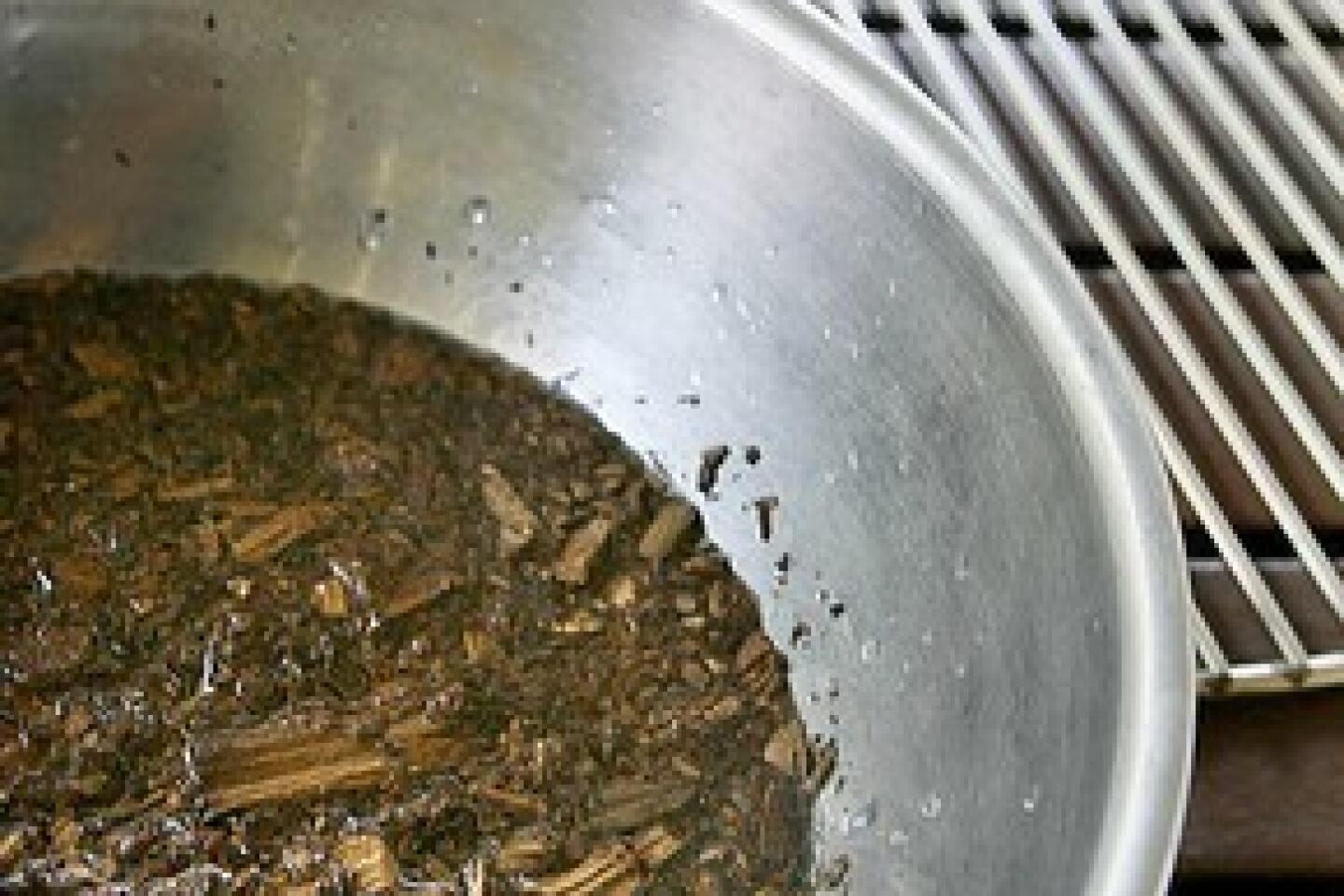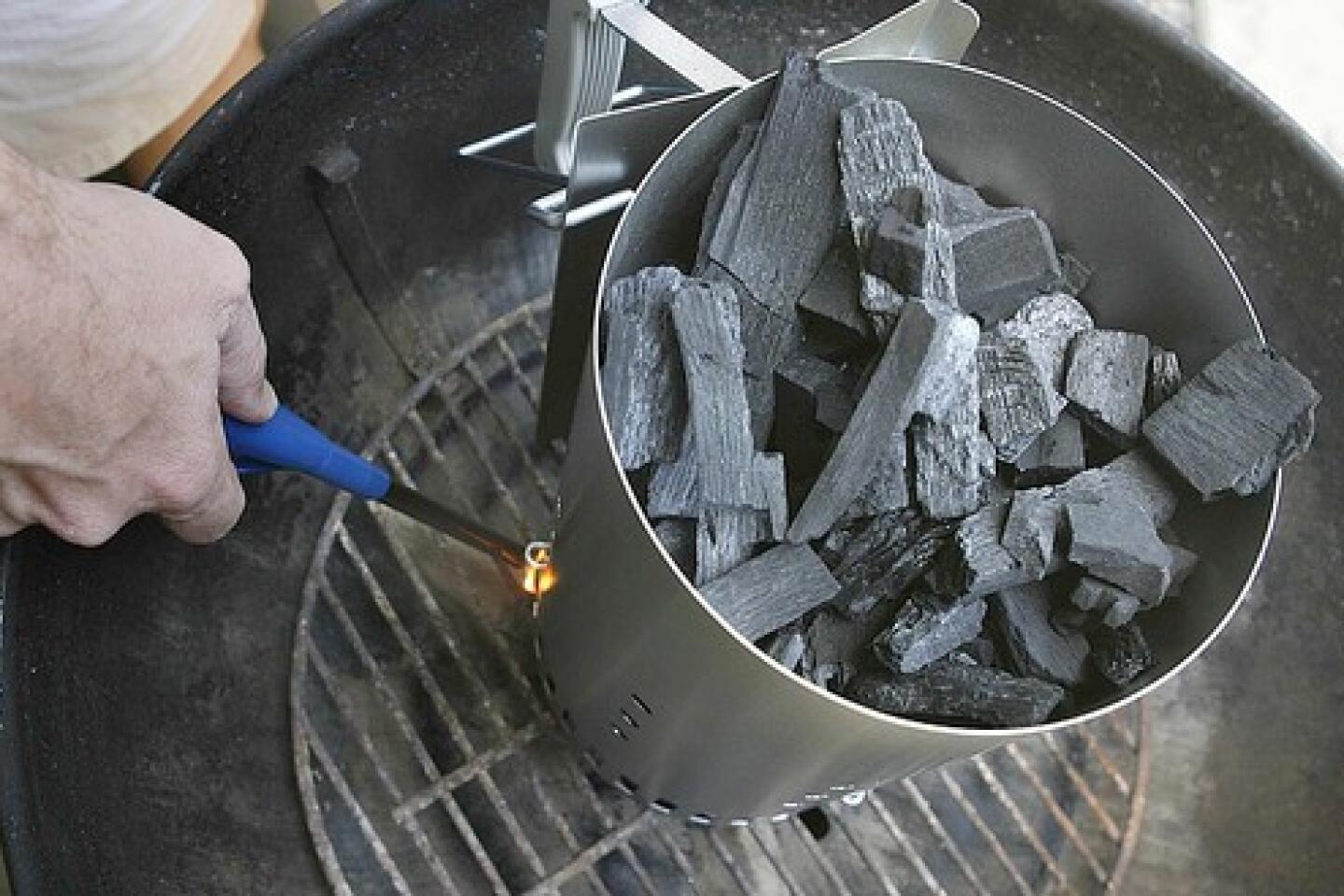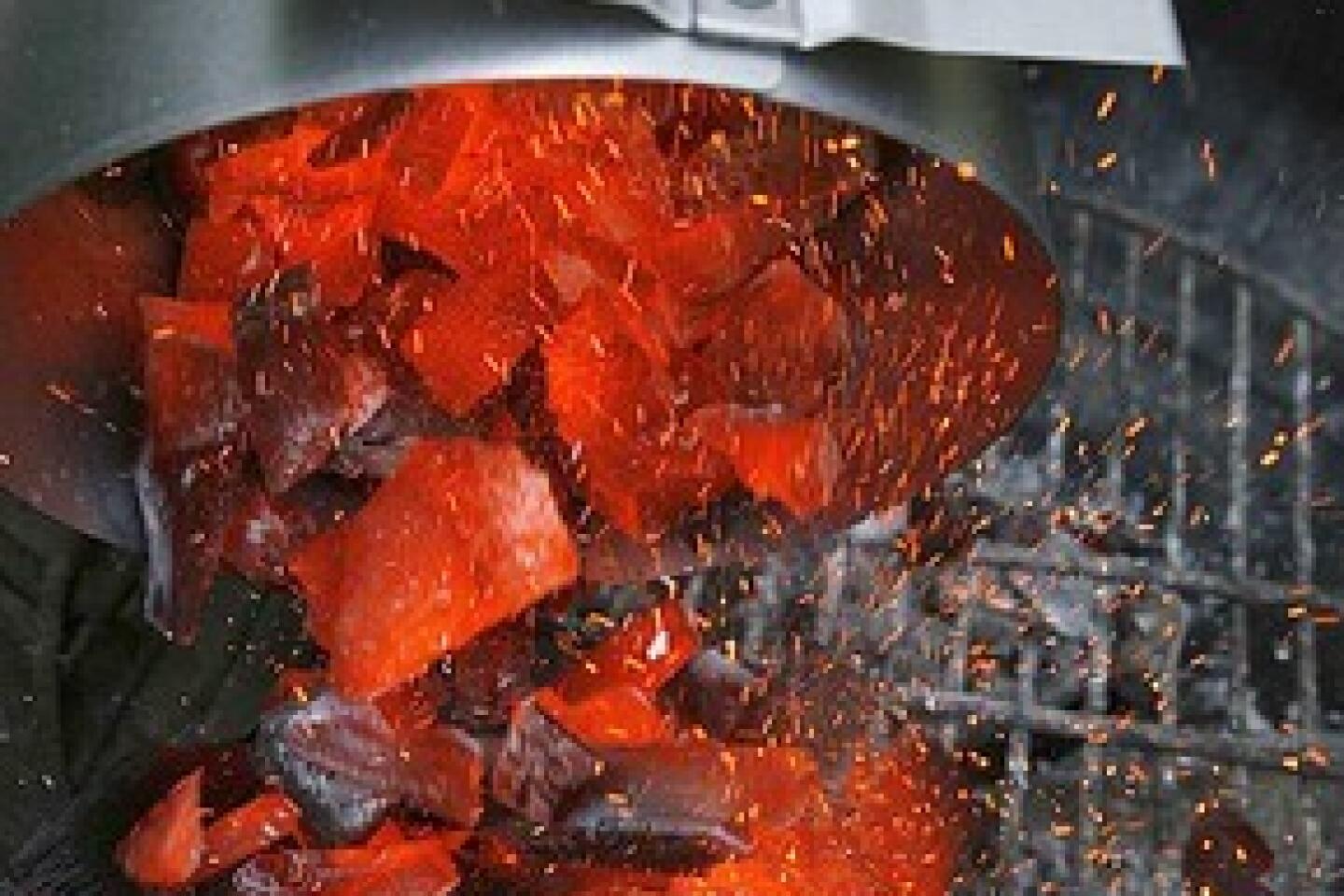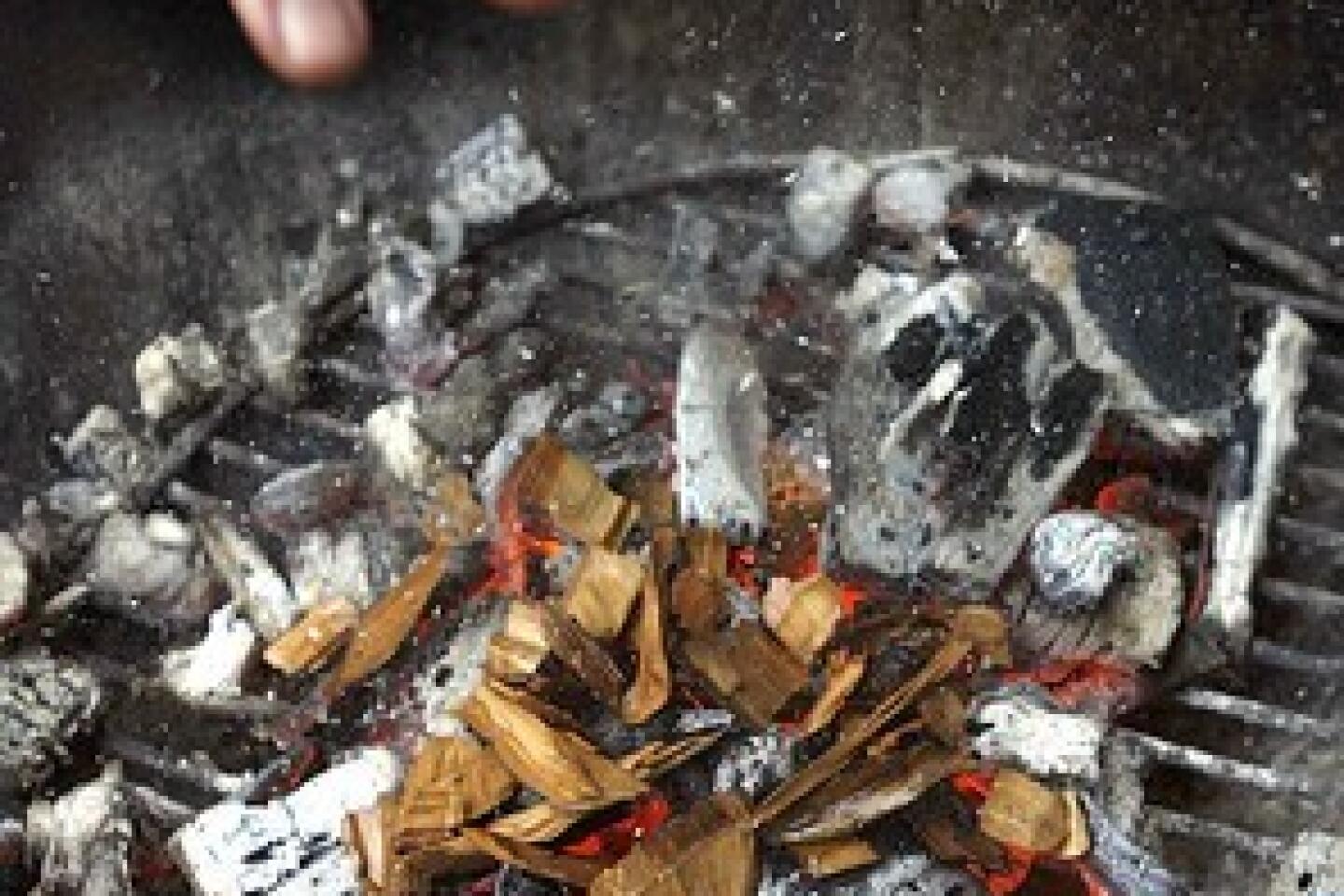SUMMER AND SMOKE
- Share via
IN the beginning, there was wood. And it was good. But it was awfully inconvenient.
The appeal of wood smoke is almost primal. In fact, just those two words by themselves are enough to make you hungry.
Along with the smells of ripe tomatoes and perfect peaches, wood smoke is an integral part of summer’s sweet perfume. It lends depth to the flavor of chicken, sweetens the taste of pork and helps give steak its sizzle.
It’s so delicious that some restaurants even build their menus around it. But until fairly recently, unless you were a barbecuing insider, it was pretty difficult to get that bouquet in your backyard.
Now all that has changed. Cooking with real wood flavor has become so easy you can do it every day.
Finding wood for grilling has always been a problem — especially in urban Southern California. You can’t just go lighting any old logs you find. Fireplace wood — mostly pine and cedar — contains sticky resins that will coat your food. Some woods will burn too fast to be any good; others will burn too slow.
Even if you did manage to find good wood, you’d have to add another hour or so to the cooking process to allow the fire to burn to coals and rid itself of the unwanted flavors most woods have.
And as a friend who is chef at a restaurant where a wood-fired grill is central to the kitchen says, to use it well you have to learn to cook not only the food, but also the fire at the same time. Getting the fire to the right point and keeping it there, and juggling the daily changes in hot spots are every bit as tricky as judging the exact moment a pork chop is done.
In the interest of convenience, most grillers use charcoal, which is wood that has already been burnt clean. You can find it either in its lump form or in briquettes — lump charcoal that has been ground down to dust and then stuck back together in uniform shapes so it burns evenly.
These are very convenient and work pretty well, if all you’re interested in is generating heat. But they add precious little flavor to whatever you’re cooking.
To get that wood-smoke flavor, the best solution for the backyard griller is wood chips. And there’s good news on that front.
Picking the perfect chip
WOOD chips — they basically look like what you might sweep up off a carpenter’s floor — have been around forever, but until not so long ago they could be found only at barbecue shops that catered to the hardwood hard-core. Lately, however, they’ve been showing up at even my neighborhood supermarket. And a visit to a gourmet grocery last week turned up six kinds of wood chips.These are simple to use: Just soak them in water for a half-hour or so, then toss them on the fire once it’s going. They work great, pumping out smoke like there’s no tomorrow.
But the sudden availability of all of these choices is a little overwhelming. Apple, cherry, mesquite — even chips made from old wine barrels. Which one to choose? Should you go with hickory, the traditional choice of most pit barbecuers? Or would oak — the California wood of choice — be better? Should you use the same wood for a beefy tri-tip as for a delicate chicken breast? And what about fruit woods, such as apple and cherry?
To find out, I fired up a couple of grills in my backyard one day and worked my way through seven types of wood chips, using each to cook pork, chicken and beef. By the end of the afternoon I was sweaty and pretty well smoked myself, but at least I had some answers.
The first thing that needs to be said about using these wood chips may seem obvious: Smoke tastes like smoke and that is the dominant flavoring. If you’re expecting dramatic differences from one variety to the next, you may be disappointed. It’s not a mustard and ketchup thing, but more like the differences between different types of mustard.
But there are differences, even if they are nuanced, and they do affect the way the smoke flavors the meat.
The first big difference is intensity. Some chips make foods taste profoundly smoky, whereas others add only a grace note. The smokiest woods, in roughly descending order, are hickory, oak and cherry. The mildest are the wine cask chips, pecan, apple and mesquite.
Another difference is an elusive quality that I suppose you could call “sweetness,” though that seems like an odd attribute for something such as wood smoke. This isn’t true sweetness — like sugar — but maybe the absence of the harsh qualities you sometimes find in wood smoke. The sweetest woods are mesquite and apple. That same quality is also there in cherry and hickory, though it’s a little harder to discern because they are so smoky.
Also, some chips have distinctive flavor notes. I found a peculiar nuttiness in pecan wood, but to me it tasted more like peanuts than pecans. The wine cask wood actually did carry an undertone of red wine.
There was an elusive characteristic in the flavor imparted by oak smoke that I found appealing but had a hard time describing. Finally, it occurred to me that what I liked about it was that it seems to be smoky but always in a graceful way. It’s more Chanel No. 5 than Brut 33.
So which woods go best with which meats? For strong-flavored beef and lamb, I’d recommend hickory, oak, cherry and apple. For mild chicken and fish, use mesquite, apple or pecan — and because of the others’ fruity qualities, probably only mesquite for fish. For pork, use cherry, hickory, pecan or apple.
I started the fires in the usual way. As far as I’m concerned, a chimney starter is the only way to go. These are nothing more than bigger and slightly fancier versions of the old coffee can starters your dad may have used.
As for the charcoal, grilling purists usually prefer lump because it burns a little hotter and leaves less ash to clog the grill’s vents. Briquettes don’t get to quite as high a temperature, but they last much longer. The bottom line is that for the 30 minutes it takes to grill most foods, the two work about equally well.
When the coals are ready, spread them evenly if you’re cooking something small, which will cook quickly. That gives you the most surface area exposed to the greatest amount of heat.
More often, though, you’ll probably be cooking things such as steaks, pork chops or even roasts, which are thicker and will take a little longer. For these foods, pile the coals against one side of the grill, leaving the other side empty. This gives you a hot spot on which to sear the meat, and a cooler area where it can cook to an even doneness.
A big part of the art of grilling is juggling these two zones — moving meat from high heat to low, and occasionally back again, in order to get it perfectly cooked. If you want to add more coals, scatter them across the top of those that have already been lighted. They’ll be ready in less than 10 minutes.
Match your meat
AFTER all my experiments with wood chips, it was time to turn theory into practice (and dinner), coming up with three main courses that highlight the best combinations of wood smoke and meat.Butterflied leg of lamb is one of my favorite cuts for grilling. Have the butcher bone it for you, and if you’re not getting a full leg, make sure you get the half that comes from the butt, not the shank. There’s much more meat and a lot less sinew.
One of the great advantages to a butterflied leg is that there is a wide range of thickness in the meat. This translates into a wide range of doneness. When the thick part from the back of the leg is rosy medium rare (about 115 degrees), the thin parts from the front will be medium. Perfectly cooked meat for both you and Uncle Earl.
Grill it over oak or cherry or — even better — the chips made from wine casks; you really do pick up a subtle flavor of red wine. The tapenade served with the lamb is an especially good complement; it gets an herbal complexity from fennel seed and a little bit of Pernod liqueur that is stirred in right at the end (add it too early and it loses its fragrance).
Because halibut is so lean, it can be a tricky fish to grill. It dries out almost instantly. And with so little fat to lubricate it, it tends to stick to everything it touches. That’s an easy problem to solve, though: Wrap it in a sheet of prosciutto.
The prosciutto renders a little fat, moistening the meat and keeping it from sticking. More important, the salty pork taste is a wonderful complement to the subtle flavor of halibut. Mesquite is the best wood for this recipe, because it adds a mild, slightly sweet taste of smoke that doesn’t overwhelm the fish.
Serve the fish with a bright salad of gold and red grape tomatoes. These are among the earliest varieties of tomatoes to ripen, and considering all of the weather-delayed planting this spring, they are among the best-flavored in the market right now.
Pork tenderloin has to be among the most underappreciated cuts of meat for grilling. It has good flavor, is reliably tender and stays moist (especially when brined).
And it takes only minimal preparation. The main thing you have to do is remove the tough, shiny silverskin that coats part of the muscle. Leave it on and the tenderloin will become misshapen during cooking. It’s easy to remove: Slip a paring knife under one end of the silverskin, grab a good hold and then pull up, scraping against the silverskin with your knife. You’ll have to repeat a few times until it’s all gone.
Use cherry, pecan or apple for the tenderloin. These are slightly sweet woods that are just a little smokier than mesquite, so they balance perfectly with the flavor of the pork.
Serve the pork with this Tuscan version of home fries. Cook quartered potatoes on the stove top very slowly with red onion until the onion caramelizes and the potatoes crisp and brown on the outside. For the last 10 minutes, add just a hint of rosemary to balance the sweetness of the onions.
Though steaks and hamburgers are great for every-night meals off the grill, these dishes are worthy of being the centerpieces at your next big-deal dinner party, and without requiring much additional effort.
Early in the day, prepare the meat and fix whatever side dishes you choose. Then just before the guests arrive, start the fire — it’ll be ready to cook on by the time you’re done with drinks and appetizers.
Put the meat on the grill and breathe in that mingled perfume of wood smoke and sear. That’s the sweet — and now even convenient — smell of summer.
Wood chips are available at selected barbecue supply stores, hardware stores and supermarkets including California Charcoal & Firewood in Commerce, (323) 780-6000, https://www.calchar.com ; Barbecues Galore stores; Orchard Supply Hardware (OSH) stores; Lowe’s stores; Ralphs markets; and selected Bristol Farms markets. Online sources include https://www.barbecue-store.com and https://www.amazon.com .
*Grilled butterflied leg of lamb with olive-fennel tapenade
Total time: 55 minutes, plus 2 hours marinating time
Servings: 6 to 8
Note: Use wine cask chips for this, or oak or cherry. Prepare the tapenade while the meat is marinating.
Grilled leg of lamb
1 (2 1/2 -pound) butterflied leg of lamb3 to 4 cloves garlic
1 teaspoon kosher salt
Freshly ground black pepper
3/4 cup red wine
1. If the lamb has been tied into a roll, untie it and lay it flat, skin-side down. There will be a range of thicknesses to the meat, with some areas fairly thin and some very thick. Slice partway through the thickest portions to allow the meat to lie flat.
2. Slice the garlic into thin slivers. Turn the lamb over so that the skin side is facing up. Use a paring knife to cut slits all over the skin side roughly a half-inch deep and a half-inch apart. Stuff a garlic sliver into each slit (it’s easiest if you use the tip of the knife to hold the slit open; don’t worry about everything being perfectly neat).
3. Sprinkle both sides of the meat with salt and pepper and place it in a zip-lock bag. Pour the wine over the lamb, press out all the air and refrigerate for at least a couple of hours to marinate.
4. When you’re ready to cook, soak about 2 cups of wood chips in water to cover. Light the coals and when the coals are glowing hot, empty them into one side of the grill, banked against the side. Drain the wood chips and place on top of the coals.
5. Pat the lamb dry with a paper towel and place it skin-side down over the hottest part of the fire. Sear the lamb 3 to 5 minutes per side, until browned.
6. Turn the meat again and move it to a cooler part of the grill and cover. Cook 10 minutes on one side, turn and cook about another 10 minutes, until a thermometer inserted into a thick part of the meat reads 115 degrees. That makes about 30 minutes cooking total. After allowing the lamb to rest, this will give you a range of doneness from medium-rare to medium.
7. Remove the meat from the grill and set aside 10 minutes to rest before carving against the grain. Serve with tapenade on the side.
*
Olive-fennel tapenade
1/2 pound pitted black olives in brine2 teaspoons minced garlic
1 1/2 teaspoons fennel seed
1/2 teaspoon red wine vinegar
2 tablespoons olive oil
1/2 teaspoon Pernod
1 tablespoon minced parsley
1. Rinse the pitted black olives, shake them dry and place them in the bowl of a food processor.
2. With a mortar and pestle, pound the garlic and the fennel seed into a coarse paste and add it to the black olives along with the vinegar and the olive oil.
3. Pulse into a coarse paste that holds together; add a little more olive oil if the mixture is too dry. Cover tightly and refrigerate until ready to serve.
4. When almost ready to serve, remove from the refrigerator and stir in the Pernod and parsley. Makes 2 cups.
Each of 8 servings: 254 calories; 27 grams protein; 3 grams carbohydrates; 1 gram fiber; 14 grams fat; 4 grams saturated fat; 85 mg. cholesterol; 390 mg. sodium.
*Prosciutto-wrapped halibut with grape tomato salad
Total time: 25 minutes
Servings: 6
Note:Use mesquite wood chips.
6 halibut fillets (2 pounds), about 2 inches thick
Salt and freshly ground black pepper
6 slices thinly sliced prosciutto (about 3 ounces)
1 1/2 pounds yellow and red grape tomatoes
6 basil leaves, thinly sliced
1 1/2 tablespoons olive oil
1 teaspoons red wine vinegar
1. Cut the fillets into equal-sized pieces about as wide as a slice of prosciutto. Because of the size of a halibut fillet, you will probably end up cutting across the fillet, making pieces that are roughly square.
2. Lightly salt and pepper the fish. Lay a prosciutto slice on the work surface and put a piece of halibut in the middle of it. Fold the ends around the halibut. It will look a little messy on the side where the ends meet, but don’t worry; you’ll serve it with that side down. Refrigerate the halibut until ready to cook.
3. Cut the tomatoes in half and place them in a bowl. Add three-fourths teaspoon salt and toss to coat well. Set aside to let the salt draw out some of the tomato juice.
4. When you’re ready to cook the fish, soak about 1 cup of wood chips in water to cover. Light the coals in a chimney and when the coals are glowing hot, empty them into the center of the grill. If there aren’t enough coals, add more on top and wait until they are glowing as well. Drain the wood chips and place on top of the coals.
5. Toss the tomatoes with the basil, olive oil and vinegar.
6. Spray a grill basket with nonstick cooking spray or rub lightly with oil. Place the halibut packages in the basket and place over the fire. Cook, uncovered, on one side until the prosciutto has lightly crisped, 4 to 5 minutes. Turn and cook until a knife inserts easily into an uncovered part of the halibut, another 4 to 5 minutes. Don’t overcook the halibut; even with the prosciutto wrapping, it will dry out pretty quickly. Total cooking time should be about 10 minutes.
7. Carefully open the grill basket, making sure the prosciutto doesn’t stick to it. Place the halibut packages on a large platter with the neatest side facing up. Spoon the tomato salad around the outside of the platter, sprinkle with black pepper and serve immediately.
Each serving: 253 calories; 37 grams protein; 6 grams carbohydrates; 2 grams fiber; 9 grams fat; 2 grams saturated fat; 60 mg. cholesterol; 760 mg. sodium.
*Brined pork tenderloin with `Tuscan home fries’
Total time: 1 hour, 20 minutes, plus overnight brining time
Servings: 6
Note:Use cherry, apple or pecan wood chips.
2 (1-pound) pork tenderloins
Kosher salt
1 tablespoon sugar
1/2 gallon water
1 1/2 pounds waxy potatoes
1 large red onion (about 2/3 pound)
1/4 cup olive oil
1/2 teaspoon minced fresh rosemary
1. Trim the pork tenderloins, removing any loose pieces of meat. Remove the silverskin: Slip a paring knife underneath it and cut one end free. Grasp that end tightly and lift up, scraping the silverskin with the knife to separate it from the meat. Repeat until all silverskin is removed. Place the tenderloins in a zip-lock bag.
2. In a large bowl, stir together one-third cup salt, sugar and water until completely dissolved. Pour the mixture over the tenderloins, seal tightly and refrigerate overnight.
3. About 90 minutes before serving, cut the potatoes into pieces about the size of walnuts. Cut off the top and bottom of the red onion and cut the onion into half-inch wedges. Place the potatoes and onion in a heavy skillet, sprinkle with 2 teaspoons salt and drizzle with the olive oil. Toss to coat well.
4. Place the skillet over medium-low heat, cover and cook for 30 minutes, checking after 15 minutes to stir. Stir gently to keep from separating the potatoes from the browning surface: shaking the pan from side to side will free most of the potatoes; those that stick can be gently pried loose with a thin spatula.
5. After 30 minutes, remove the lid and continue cooking, carefully stirring occasionally, until the potatoes are well-browned and crusty, another 30 to 40 minutes. Add the minced rosemary, reduce heat to very low and continue cooking another 10 minutes. The potatoes will hold this way until ready to serve.
6. While the potatoes are cooking, start the pork. Soak about 1 1/2 cups of wood chips in water to cover. Light the coals in a chimney and when the coals are glowing hot, empty them into one side of the grill, banked against the side. Drain the wood chips and place on top of the coals.
7. Pat the pork tenderloins dry with paper towels and place the meat directly over the flame to sear for 3 to 5 minutes. Turn and sear on the other side for another 3 to 5 minutes. Move the tenderloins to the cooler part of the grill, cover and cook 6 to 10 minutes or until the temperature reaches 150 degrees on an instant-read thermometer.
8. When the tenderloins are done, remove them to a carving board and let them rest 5 to 10 minutes. Slice them into half-inch thick medallions and put them on a warmed platter along with the crusty fried potatoes. Serve immediately.
Each serving: 348 calories; 32 grams protein; 21 grams carbohydrates; 2 grams fiber; 14 grams fat; 3 grams saturated fat; 84 mg. cholesterol; 426 mg. sodium.
More to Read
Eat your way across L.A.
Get our weekly Tasting Notes newsletter for reviews, news and more.
You may occasionally receive promotional content from the Los Angeles Times.















